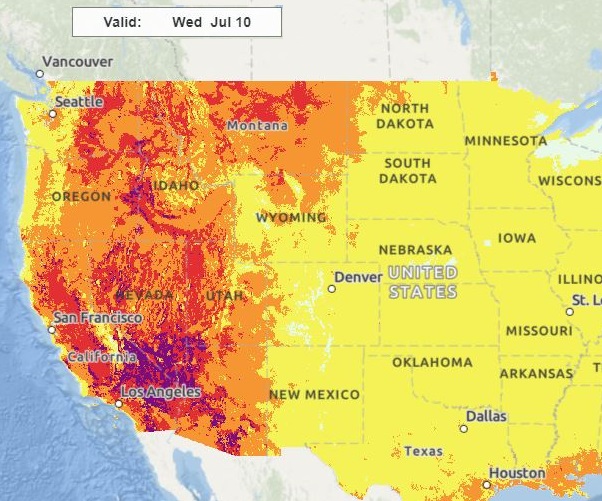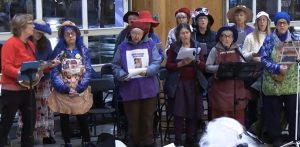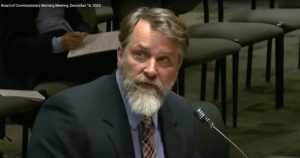Extreme heat eases; county was prepared to open 24-hour cooling center
11 min read
With the extreme heat event winding down July 9, Lane County has seen just 12 heat-related emergency room visits, and so far, no known heat-related deaths.
Tiffany Brown (Lane County emergency manager): The Emergency Management Department had a real opportunity during this last week to support Public Health and the Human Services Division partners, a specific opportunity to really focus on mass care.
[00:00:23] It is one of our most important functions and without the distractions of added events or hazards that were occurring, we were able to just really double down and partner with the Public Health and Human Services Division to understand how we make that system work better.
[00:00:39] For my part, our primary function was to host and stand up a cooperators’ call every day. We had I think 35 people on the call during the Fourth of July holiday, which I think is a good indication there was a real commitment for people to show up. I received a number of requests to be added and I think at the last check, we now have 195 people registered to receive that notification when we activate the Emergency Operations Center and when we stand up those cooperators’ calls.
[00:01:09] They do work. People get information, maybe not in real time, but updated at the same time and they hear the information at the same time and it’s really valuable. I’ll say that the information didn’t change tremendously after the first couple of days, but the value in these is that if something were to happen, if the situation worsened, or if, or we’re in wildfire season, something else happened, we have that vehicle in place so that we’re able to just quickly assimilate information and resources into that.
[00:01:41] I want to commend the Public Health and Health and Human Services staff for their response. They were really leaning into this. It was a pleasure to support them. And I didn’t respond to COVID in this county, but in a similar way, I feel like we kind of got the band back together because what I did for them in the past week is what I did for about nine months for my public health department back in Clatsop County. So, that was an experience that paid off, I think, this last week.
[00:02:10] Our state partners were at the table again. They showed up for the cooperators’ calls. Really, we were just leaning into this. We drew a number with the state for an incident so we could rapidly request resources. We stood up the cooperators calls. We did a walkthrough of the Emergency Operations Center with everyone who has a hand in that. We hoped against a wildfire, but we felt like we were as ready as we could be if something else happened.
[00:02:34] So in that way, by supporting our county partners and our cooperators, we were able to build a muscle for anything that might be coming at us this summer.
[00:02:46] Eve Gray (LCHHS director): For this particular event, we maintained activation as a department operation center, though we were very closely coordinating with our emergency manager and prepared to initiate a county-level response if that would have become necessary.
[00:03:03] So, I have been serving as incident commander for this event. We are getting ready to demobilize here at the end of the day today.
[00:03:12] We first became aware through our public health preparedness team, on Tuesday (July) 2 that we were being upgraded from a heat watch to a heat warning by the National Weather Service, and that triggered us to think about, this is likely to be a sustained event with triple-digit temperatures and minimal overnight cooling.
[00:03:35] That’s when health risks come into play when we’re looking at heat events. At the time we were looking at worst-case scenarios in the 10% range that this would be an extended heat event of 110 degrees or more.
[00:03:49] So given that possibility as well, we felt that we needed to activate to make sure that we were monitoring the situation and prepared to respond to the community’s needs.
[00:04:02] So the ways that we activated within public health: We had Emergency Support Function 8, and that is health and medical. They were monitoring a couple of things. One is the National Weather Service reports, attending those every day from (July) 2 through the weekend, and today was the last day of our daily calls.
[00:04:22] Also, we’re monitoring a system called ESSENCE. It’s a state system that the emergency departments feed data into, and that tells us if there are emergency room visits related to heat. We also monitor other things like asthma because the air quality has been a little bit poorer, not terrible during this event, but the heat dome events often cause a reduction in air quality.
[00:04:48] So we were monitoring ER visits for asthma as well as drowning-related incidents because we know that that is more common when people are seeking respite in the water, and some other things, GI illness, as well as we look at rates of unhoused individuals accessing the emergency department, which is again, just another trigger for us about if that spikes, our services for our unhoused population may not be where they need to be.
[00:05:14] So all of these are little data points that could give us information throughout the activation around, was what we were doing working for the community, or did we need to step things up?
[00:05:26] We also had activated Emergency Support Function 6 through the Human Services Division. This is mass shelter, mass care and sheltering. And, initially in a heat response event for housed community members, we tend to focus on publicly available spaces that are open during the day already to go and have cooling resources.
[00:05:49] We were very fortunate to have partnership from the city of Eugene and the city of Springfield, who extended hours for their City Hall and Springfield library location, downtown library location in Eugene and also relax some of the restrictions in Eugene on pets, on food, so that they could provide additional access to the community for cooling.
[00:06:13] So for housed community members, usually those publicly available spaces and access to waterways and all of the other ways that housed community members manage through a heat event, usually that is adequate. What we know is that our unhoused neighbors become at risk much sooner than many of our housed neighbors.
[00:06:34] So we worked with St. Vincent de Paul, they activated (thanks to some Lane Community Health Council funding that was received this year) cooling center operations starting on Saturday and they will shut their operations today. They saw only 12 the first day, but the second day they had 40 and yesterday they had 44 individuals accessing services through this cooling center that they were running, which is an indication to us that that was a necessary service and we’re glad that we could provide it within the community.
[00:07:11] We also were coordinating through Emergency Support Function 6, with the local heat collaborative. And we did an activation of that heat collaborative which triggered LTD to provide free bus rides to cooling centers.
[00:07:27] We also partnered with Food for Lane County. They provided bottled water and actually delivered three pallets to Oakridge yesterday, with Oakridge requesting some support in that regard. And again, just monitored any challenges that we thought we would be facing within the cooling center locations that we had identified.
[00:07:48] In addition to Emergency Support Function 6, communications was a very big part of our response. So, our interim PIO (public information officer), Del Borden, focused on getting messaging out all weekend long. The communications team worked with our leaders in ESF 6 and 8 to make sure that all of the cooling center lists were updated on a daily basis as we identified new pop-up cooling centers that were happening in different communities. Those were added to our list.
[00:08:18] We were pushing that out through social media, through press releases and through community partners who have their own mailing lists.
[00:08:26] We were also reaching out to the hospitals, making sure that on-site leadership through the weekend—charge nurses, house supervisors—had access to the cooling center resources and also phone numbers for our coordinated care organizations who were also working all weekend to respond to Medicaid member requests. They had also done proactive outreach before the weekend to reach out to known at risk members in order to make sure that they had a plan to be safe through the weekend. So overall, very good coordination.
[00:08:59] We had a total of (I believe) 12 heat-related emergency department visits throughout the weekend while we were monitoring ESSENCE. That’s very low for an incident of this nature. As of today, we have reached out to the medical examiner, as well as death investigators in the hospitals. We have no known heat-related deaths related to this incident in Lane County. Now, there is still the possibility that someone could be found. That is, people who are alone in their homes, sometimes are not able to recognize the signs and symptoms.
[00:09:33] We did do a lot of communication, asking for people to check on their neighbors who lived alone, but that continues to be an area of risk for us. And of course, this is another day of heat and we have an additive effect, but as of now, we have no known heat-related deaths.
[00:09:48] Commissioner Heather Buch: I was wondering, what is the temperature trigger for a heat-related event for the EOC (Emergency Operations Center)? I know there’s one when it’s cold for Egan (Warming Centers), but I have forgotten what the trigger is on the other side of the scale.
[00:10:09] Eve Gray (LCHHS director): With this event, we went with the National Weather Service designation of a heat-related warning. If we are heating up, but then we don’t have very many days sustained, the risk is lower. If we are heating up, but then cooling down really well at night, the risk is lower.
[00:10:33] What the National Weather Service is doing is looking at how many sustained days expected over 100 degrees and what is the expectation for those nighttime cooling trends. And that then causes them to give a risk level associated with the heat, and there are colors associated with that. So, red and magenta are the colors that we are worried about. And we had entered into those colors and had gone into a heat-related warning which caused us internally with Health and Human Services to activate and then have emergency operations at the county kind of on ‘warm mode’ in case this were to become a really major event and we would need assistance.
[00:11:19] Commissioner Ryan Ceniga: Ms. Gray, you said we had 12 heat-related incidents. Define a heat-related incident.
[00:11:24] Eve Gray (LCHHS director): Sure, so this was in our ESSENCE data: Folks who visited an emergency department related to an illness that was attributable to heat… In terms of the disposition, that probably varies per individual, but this would have been an emergency room visit that, except for the heat, probably would not have happened.
[00:11:41] So that’s part of what we were looking at to identify: If we would have seen a spike in community members utilizing the hospital for heat-related reasons, we would have evaluated, are those members of the community who are housed or unhoused, which then would indicate to us what types of shelters we might need to lean into. So we were prepared, if we were seeing a spike for any of the groups, to get an overnight shelter.
[00:12:10] In effect, because that’s really the next step. If we’re not cooling off well enough at night and people are not able to recover their bodies, we need to have a 24-hour solution for individuals to stay safe. It didn’t get there in this event, but we were talking about it, we were ready for it, and we could have stood that up if that was necessary.
[00:12:34] Commissioner Laurie Trieger: Heat can have health impacts much more quickly than cold. The ice storm was really dramatic, and we heard a lot, but it doesn’t have to be very hot for very long, particularly, and I think this is where our equity lens really comes into play. If I’m a roofer or I work some kind of outdoor job in that kind of heat, it has an impact and that’s just important to note…
[00:12:56] And, people who are housed inadequately or in trailer parks or mobile homes or top-floor apartments without air conditioning are often really at risk for dehydration and heat-related illness, so I do wonder if we’ll see those numbers change.
[00:13:11] But it’s great to know that we’re ready, and I noticed lots of the communications and outreach and also shared that out, so, I think we did a really great job on that.
[00:13:18] I’ll be very curious to hear some LTD data. I’m going to reach out to them myself, because they have been really becoming a big part of hazard weather response in this community, thanks to their leadership there. And I know their downtown station has been sort of a hub for giving out water and so that’s great.
[00:13:37] You also mentioned more water rescues, and I know our Sheriff’s Office and the local police departments were very busy with a number of water rescues, so that’s a great reminder to the public to be safe on the water.
[00:13:51] And then lastly, the Lane Alerts. It’s really easy to sign up. I know we are doing a test. You can sign yourself up for it. You can say whether you want your phone to ring, you want a text alert, you want an email, you want any combination of those. And I got those alerts, so, just encouraging anybody and everyone to sign up for Lane Alerts so that you get those notifications, especially as we head into fire season when this was a fairly slow-moving emergency that then ended up not having huge impacts because of our readiness and your great work, but fire is not the same.
[00:14:24] Greg Rikhoff (for Lane County administration): We play as we practice and our chance to have an event where we did not have significant problems, we did have a chance to train, build muscle memory, really engage folks to have the conversations with Health and Human Services about making sure that material was linguistically accessible so that, we really were caring for all the communities. This will pay dividends later on.
[00:14:51] There was great participation. The partners, including the cities, which sometime have a struggle to get there and participate, they were here and really actively engaged. We had state and federal partners here as well, including representatives from elected officials’ offices.
[00:15:10] So we had a chance to, again, help reinforce some of those points, the focus, and yeah, I think Tiffany is spot on with this list becoming valuable and people are seeking us out to connect up with, so to have an event that was pretty much a non-event, but to have it work so well and build out skills and knowledge of one another, really is valuable.
[00:15:35] John Q: Lane County commissioners get an overview of the heat event that started on the Fourth of July. The county was prepared to open 24-hour cooling centers. They say checking on nearby neighbors who live alone continues to be an area of risk.





